Three months after the start of the Great Return March protests, a military confrontation between Israel and Hamas appears increasingly likely. +972 talks to two of the protests’ organizers about the challenges facing the burgeoning yet beleaguered non-violent movement in Gaza.
By Meron Rapoport
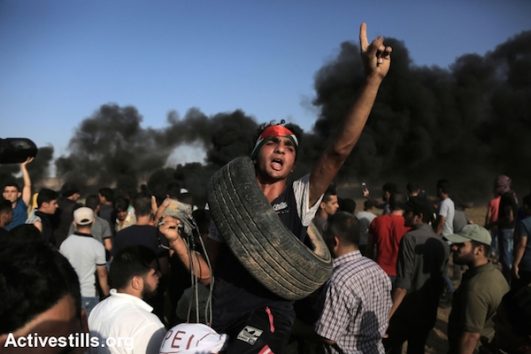
It has been nearly three months since the Great Return March protests in Gaza began. In the days leading up to the first protest on March 30, one of the organizers, Hassan al-Kurd, stressed that the demonstrations would be non-violent. “We are against throwing rocks and even burning tires,” he said. “The message we want to send is one of peace and opposition to violence.”
While it didn’t take long for stones to be thrown and tires burnt, the non-violent message largely prevailed during the Great Return March’s first weeks. And though Israel attempted to portray the demonstrations as violent acts of terror even before even they started, instances of violence were minimal relative to the size of the protests.
According to information the Israeli government presented to the Supreme Court in early May, just 25 of the more than 100,000 Palestinians who took part in the Return March protests attempted to cross or damage the Gaza-Israel separation barrier. Ahmed Abu Artema, considered the “spiritual father” of the Great Return March, said the best proof that the Return March protests remained largely peaceful is that “not one soldier was killed or wounded.”
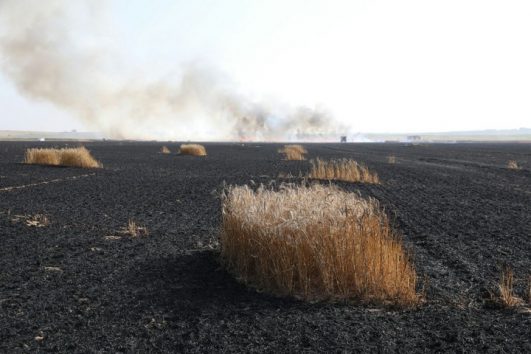
Over the past several weeks, however, the nature of the conflict between Israel and Gaza has changed entirely. The protests along the Israel-Gaza separation barrier have dwindled dramatically; last Friday, only 1,000 Palestinians took part in protests. The discourse and the means of the conflict have also, again, become violent: Israeli bombardment, Hamas rocket fire, and incendiary kites and balloons that have burnt large parts of the Western Negev. Israeli security officials quoted Monday in Haaretz warned that Hamas wants “an extensive confrontation” with Israel — these kinds of warnings are often signs that it is Israel that wants a clash. The fact is, though, that after two months of the Great Return March, the struggle is no longer one of civilian protest but a military confrontation.
There is no doubt that Israel has a significant role in the shift to violence — or, perhaps more accurately, the return to violence. Since the days of the First Intifada, Israel has been much more comfortable dealing with armed Palestinian resistance than with non-violent protests. Amram Mitzna, who during the First Intifada headed the IDF’s Central Command, responsible for the occupied West Bank, said at the time that the moment the Palestinians began to use firearms (in a very limited way) and abandoned the general strikes and protests, the army’s work became easier. In a military conflict, Israel has and always will have a built-in advantage. Against tens of thousands of civilians running toward the separation barrier — less so.
Following this logic, on April 28, the day after the fourth consecutive Friday protest, before the incendiary kites were what they are today, and even before any rocket had been launched at Israel, the IDF bombed targets it claimed belonged to “Hamas’s naval force.” According to a statement released by the IDF Spokesperson’s Unit, the targets were chosen not because they were used to carry out violent acts against Israel, but as a response to the protests along the Israel-Gaza separation barrier. “
The IDF sees with the utmost seriousness the ongoing attempts by the terror organization Hamas to turn the area near the fence into a place of violence and terror under a civilian guise,” the statement said. “The IDF will not permit the cynical use of civilians, including children, women, and people with disabilities as cover for the continuing terrorist activities against Israeli citizens and soldiers, and will continue to respond harshly to all acts of terror of this kind.”
In other words, the protests along the Gaza-Israel separation barrier, which were mainly non-violent and during which not a single Israeli soldier or civilian was wounded, were answered with airstrikes.
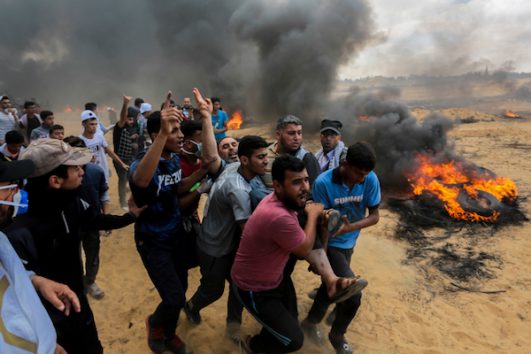
Since then, the situation has only deteriorated. The turning point came on May 14, during the mass demonstrations on Nakba Day and in protest of the U.S. Embassy move to Jerusalem, when Israeli forces killed 65 Palestinian protesters. After that, the number of Palestinians willing to approach the separation barrier decreased significantly. The fact that Hamas claimed the slain protesters as its own, portraying the majority of them as Hamas activists, certainly helped Israel frame the demonstrations as an act of terror. The launching of incendiary kites, which perhaps began as a local initiative, became planned and systematic, and clearly tied to Hamas. To be sure, incendiary kites don’t kill people, but their use is intended to cause damage and, indeed, they have burnt large swaths of agricultural lands on the Israeli side of the border with Gaza.
The use of the incendiary kites as weapons kicked up the winds of war. Though Israel is reluctant to send its fighter jets to attack kite flyers, the exchange of fire over the past weeks — Israeli airstrikes on the one hand and rocket fire by Hamas and Islamic Jihad on the other — has brought the two sides much closer to an armed confrontation. Israel has returned to its comfort zone — military conflict. But Hamas, too, has returned to its comfort zone. After adopting, at least for a period, the language of non-violent civilian struggle introduced by the organizers of the Great Return March, Hamas has returned to its familiar language of armed struggle against Israel.
The Return March organizers are not happy with the new direction of the protests that they initiated three months ago. Roughly 10 days ago, Abu Artema wrote on his Facebook page that “the Return March needs to take a step back.”
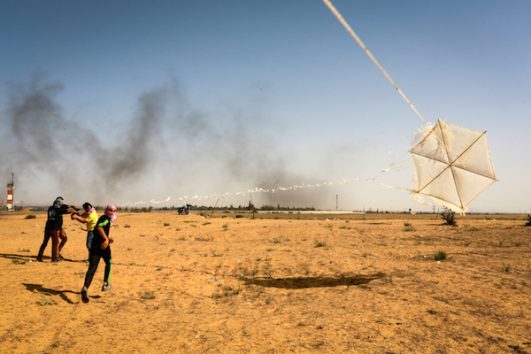
The struggle, Abu Artema explained, was a struggle over the protests’ image in order to draw the world’s attention to the Palestinians’ fight for justice — that is more important than “a direct conflict with the soldiers of the occupation,” he claimed. Instead of clashing with soldiers along the fence, Abu Artema suggested festivals, songs, plays, lectures by professors about the Right of Return, and teenagers planting trees.
“These initiatives will bolster the impression that we are a people that loves life and that we are the victims of a racist and criminal occupation,” Abu Artema wrote. If the Palestinians don’t adopt these tactics, he warned, “the occupation will use all of its propaganda means to create the opposite impression, that we a group of death-lovers demanding anarchy, fire, and destruction.” The responses to his post, the title of which was changed to “Un-armed people — don’t shoot,” were very positive.
Palestinian political commentator Awni al-Mashni, a Fatah member from Bethlehem, issued an even harsher criticism of the new direction of the protests. (Disclosure: al-Mashni is a member of the Two States One Homeland movement of which I am one of the leaders).
In an essay published by the Ma’an news agency several weeks ago, he came out in opposition to the use of incendiary kites. These means, al-Mashni claimed, “aid the occupation” because it gives the Israeli army an excuse to attack the demonstrators on the grounds that they’re causing fires. The kites, al-Mashni added, hurt the Palestinians more than they hurt Israel.
“Maintaining the non-violent quality of the popular struggle is an essential need that we must not deviate from,” al-Mashni wrote. “We need to immediately speak out against this phenomenon without hesitation but it’s not enough to speak out. This phenomenon must stop immediately.”
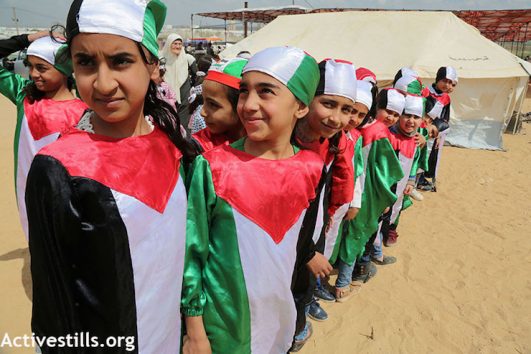
I spoke with Abu Artema early last week. He sounded cautious, but maintained what he had written in his post on Facebook. “Every human effort requires reassessment,” Abu Artema said. “The Return March was a new form of struggle against the occupation that achieved a lot and will achieve more. It created a new Palestinian awareness of means of protest. But in light of the great crime committed by the occupation government and the soldiers who killed unarmed civilians, we are looking for ways that will limit the ability of soldiers to kill unarmed civilians. This is the essence of the step back.”
You have complained that the Return March lost its non-violent character. Why did this happen?
The Return March remained mainly non-violent, and the best proof of this is that after many weeks of protests, not a single Israeli soldier was wounded or killed. The Palestinian demonstrators who participated know that the struggle is in words and protests not with guns and bullets. But at the end of the day, this was a popular event during which there were occurrences that I, personally, as well as others among the organizers, did not call for. For example, the launching of incendiary balloons and kites. We are not calling for these things. But at the same time, we reject the media’s attempt to focus on these things as if they are the problem. It is impossible to compare incendiary balloons and kites to the killing of 130 civilians and the wounding of 13,000 people. We are not calling for the incendiary kites but we don’t want to support those who claim it’s the main problem. The main problem is the actions carried out by the occupation.
There are commentators who say that the use of incendiary kites and rockets is exactly what Israel wants because it wants to present the Palestinians as violent.
I agree with this statement. The leadership of the occupation, unfortunately, lies to its people when it says that it doesn’t want violence and that it is struggling against violence, all the while it is creating the violence, because this violence serves as propaganda. Even before the Return March began, the occupation government began its propaganda campaign and spoke about the threat of non-violent demonstrations. The occupation gets stronger from the violence. It doesn’t want a non-violent struggle because non-violence embarrasses it, the non-violent struggle proves the morality of the Palestinan struggle for freedom and dignity and exposes the occupation and crimes that it carries out.
What next steps should the Return March take?
We Palestinians have no choice but to continue the non-violent popular struggle from freedom and dignity. It is our natural right. We are nation that has suffered racist oppression and segregation. Israel, unfortunately, is an apartheid regime like South Africa: it imprisons the Palestinians in ethnic cages, bantustans, discriminates against them, besieges them, imprisons them, and denies them freedom of movement. We Palestinians cannot live with this reality — we must continue to struggle until we attain freedom, dignity, and equality.
Meron Rapoport is an editor at Local Call, where a version of this article first appeared in Hebrew. Read it here.
